Inland waterway freight transport - quarterly and annual data
Data extracted in June 2023.
Planned article update: 27 September 2024.
Highlights
Inland waterway freight transport, EU, 2012-2022
This article presents the main annual and quarterly statistics on inland waterways goods transport in the European Union (EU) in 2022. It includes quarterly and annual data for total transport and container transport, and annual data for transport by type of goods, type of transport, type of vessel and type of dangerous goods. For more detailed statistics on inland waterway transport by type of goods, please refer to the Statistics Explained article Inland waterway transport statistics by product category. For more detailed statistics on inland waterway transport of containers, please refer to the Statistics Explained article Inland waterways - statistics on container transport.
Full article
Inland waterway freight transport performance sharply decreased by 9.8 % in 2022 compared with 2021
Activity in inland waterway transport was volatile during the period 2012-2022. Measured in tonne-kilometres, activity increased in 2013, followed by a decline until mid-2016. A slight increase was observed in 2017 (+0.5 %) followed by a sharp fall in 2018 (-10.9 %) and an immediate rebound in 2019 (+6.6 %) (Figure 1). In 2020, a substantial decrease (-5.9 %) was observed while in 2021 a new rebound was registered with a 3.6 % increase compared to 2020. In 2022, a sharp decline was recorded with a drop by 9.8 % (or 13 million tonne-kilometres). A similar trend can be observed for 2022 in terms of tonnes with a drop of 5.4 % (or 29 million tonnes) (Figure 5).

(billion tonne-kilometres)
Source: Eurostat - (iww_go_atygo)
At quarterly level, movement was more erratic and no seasonal pattern can be identified (Figure 2). Some noticeable changes were observed over the period 2012-2022 when comparing with the same quarter of the previous year. In particular, the year 2018 showed sharp declines in the third and fourth quarters of 2018 (-16.6 % and -25.3 %, respectively). The decline in the fourth quarter was the highest decline registered during the period from 2014 to 2022. In contrast, the fourth quarter of 2019 showed the highest increase in the period, when comparing with the same quarter of the previous year observed (+18.8 %). In 2021, increases in the three first quarters when comparing with the same quarters of the previous year (+2.8 % in the first quarter, +7.2 % in the second quarter and +8.2 % in the third quarter) while there was a fall in the fourth quarter (-3.5 %). In 2022, a decline was recorded in all quarters. The highest decline was observed in the third quarter (-25.0%) when freight transport performance in the EU inland waterways was at its lowest since quarterly data are available for the EU (i.e. the first quarter of 2006).
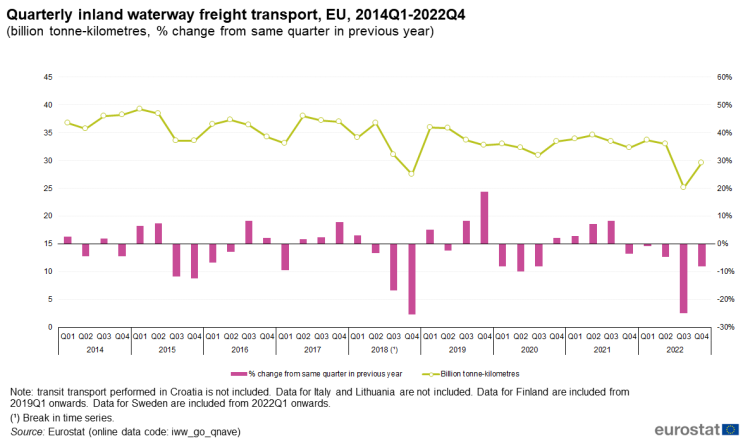
(billion tonne-kilometres, % change from same quarter in previous year)
Source: Eurostat - (iww_go_qnave)
The main contributors by far to the EU inland waterway transport (in tonne-kilometres) in 2022 were Germany and the Netherlands. Transport on inland waterways in these two countries accounted for almost three quarters (73 %) of the EU inland waterway transport (Figure 3). In 2022, the volume of transport (in tonne-kilometres) decreased in all countries compared with 2021, except in Lithuania (+251.5 %) and Finland (+30.6 %). However, these large changes in percentage should be considered in relation to a low initial value (+ 7 million tonnes and +45 million tonnes, respectively). The largest decrease compared with 2021 was recorded in Bulgaria (-34.6%, or - 2.0 billion tonne-kilometres). Three other countries reported decreases by more than 20 %: Croatia (-29.2 %, or -159 million tonne-kilometres), Poland (-25.0 %, or -13 million tonne-kilometres) and Romania (-20.4 %, or -2.8 billion tonne-kilometres). Three additional countries recorded a drop between 18 % and 20 %: Hungary (19.5 %, or -0.4 billion tonne-kilometres), Slovakia (18.9 %, or -0.2 billion tonne-kilometres), and Austria (-18.1 %, or -0.3 billion tonne-kilometres). Five more countries recorded falls between 5 % and 10 %. The Netherlands registered the lowest decrease, by -4.4 % (or 2.0 billion tonne-kilometres). In absolute values, Germany registered the highest decrease in 2022 compared with 2021 (-4.1 billion tonne-kilometres, or -8.5 %).
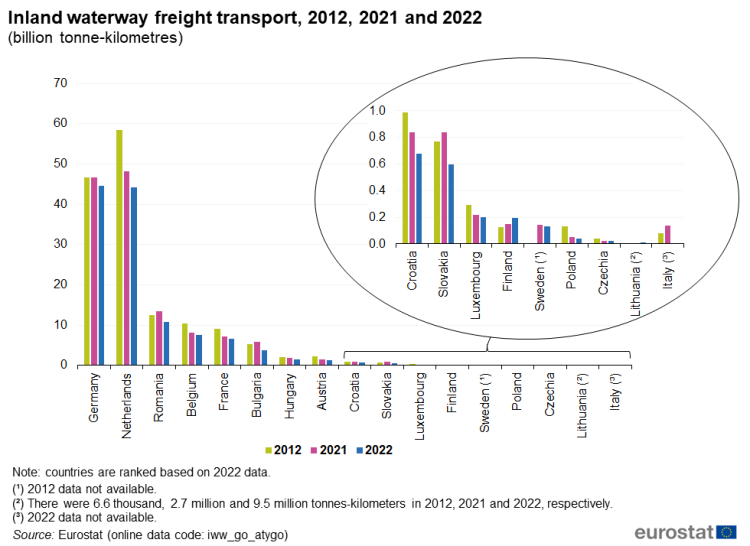
(billion tonne-kilometres)
Source: Eurostat - (iww_go_atygo)
When looking at the type of transport at EU level, international transport accounted for more than half of the total transport in 2022 (56.6 %), when expressed in tonne-kilometres. National transport accounted for 25.3 % and transit transport for 18.1 %. For five countries, international transport represented the highest share of transport. Austria (74.7 %) and Germany (67.4 %) had the highest shares of international transport in 2022. In Italy, Lithuania, Finland and Sweden, there is only national transport. In Czechia, Poland and France, national transport was predominant (88.7 %, 74.0 % and 62.4 %, respectively). The five remaining countries, Bulgaria, Croatia, Luxembourg, Hungary and Slovakia had higher shares of transit transport, mainly due to their geographical position, with shares higher than 85 % in Bulgaria, Croatia, Luxembourg and Slovakia.
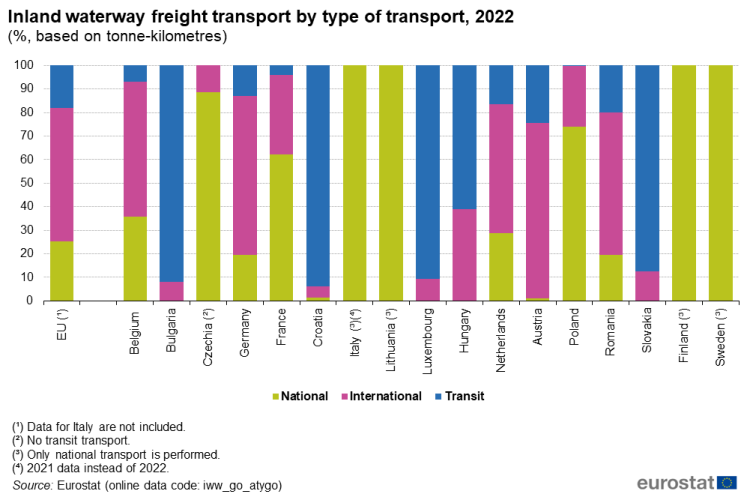
(%, based on tonne-kilometres)
Source: Eurostat - (iww_go_atygo)
When looking at the transport of freight in tonnes, the picture is quite similar to the one for tonne-kilometres with some noticeable differences (Figure 5). All countries recorded decreases in 2022 compared with 2021, except in Lithuania (+105.3 %), Finland (+24.5 %) and Sweden (+20.8 %). However, these large changes in percentage should be considered in relation to low initial values. It should be noted that while Sweden registered a substantial increase in the transport of goods measured in tonnes, a decrease was observed in the transport of goods measured in tonne-kilometres. The largest relative drop was registered in Poland with -55.7 %. However, this large change in percentage should be considered in relation to a low initial value, with absolute values decreasing from 2.1 million tonnes to 918 thousand tonnes. Other countries with substantial falls were Bulgaria (-30.6 %), Croatia (-29.3 %), Hungary (-26.2 %), Austria (-22.9 %), Slovakia (-13.9 %), Romania (-10.9 %) and Luxembourg (-9.1 %).
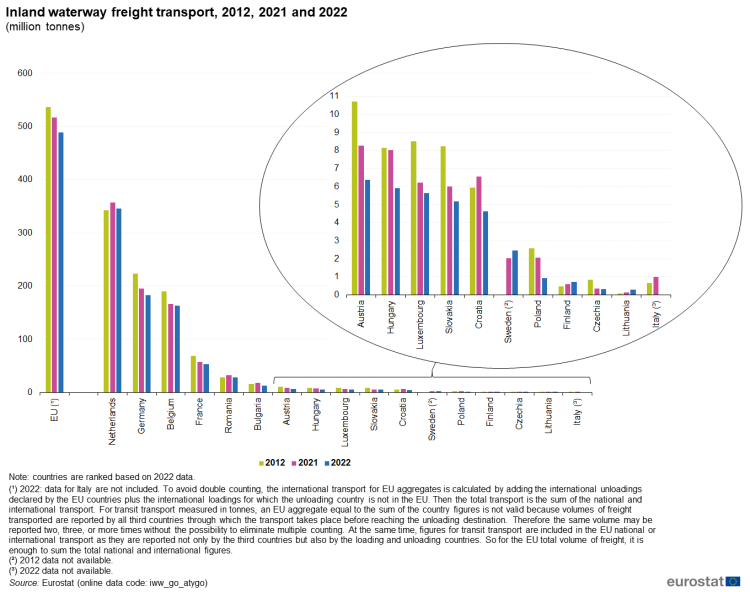
(million tonnes)
Source: Eurostat - (iww_go_atygo)
Looking at the volume of freight transported per inhabitant, at EU level, 1.1 tonnes were transported on inland waterways in 2022 (Figure 6). The Netherlands had the highest volume with 19.6 tonnes per inhabitant, followed by Belgium (14.0 tonnes per inhabitant) and Luxembourg (8.8 tonnes per inhabitant). All other countries registered less than 2.5 tonnes per inhabitant in 2022; for six EU Member States, Sweden, Finland, Lithuania, Czechia, Poland and Italy (2021 data) less than 250 kilograms per inhabitant were transported.
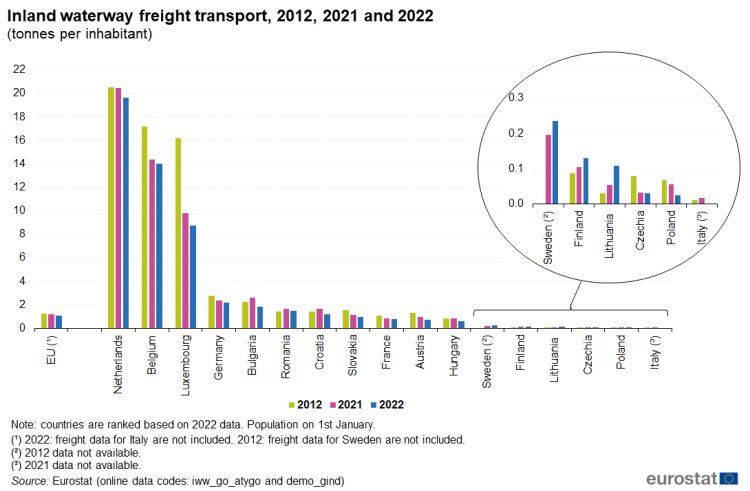
(tonnes per inhabitant)
Source: Eurostat - (iww_go_atygo) and (demo_gind)
‘Metal ores’ is the largest goods category transported
At EU level, the main types of goods (according to NST_2007 classification) transported in 2022 were ‘metal ores’, ‘coke and refined petroleum products’ and ‘chemicals, rubber and plastic, nuclear fuel’. These top three categories accounted for more than half (50.7 %) of all goods transport on EU inland waterways (Figure 7). Compared to 2021, the largest changes in the share of the different goods types in total transport performance were recorded for ‘coal and crude petroleum’ (increase by 2.1 percentage points) and ‘products of agriculture’ (decrease by 1.7 percentage points).
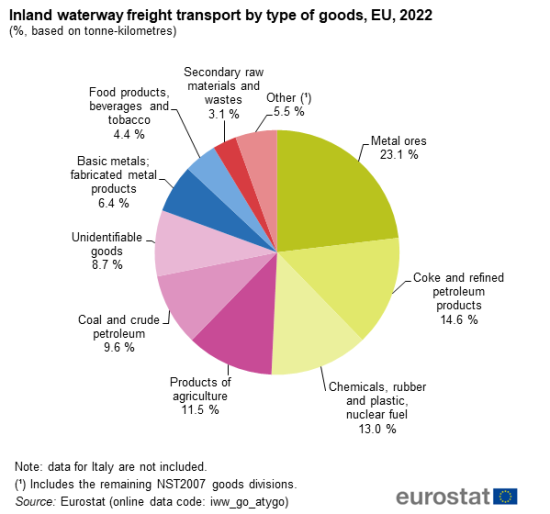
(%, based on tonne-kilometres)
Source: Eurostat - (iww_go_atygo)
Transport performance (in tonne-kilometres) linked to the types of goods presented recorded an increase in 2022 compared with 2021 only for ‘coal and crude petroleum’, by 15.3 % (Figure 8). In contrast, the largest transport performance decrease was observed for ‘products of agriculture’ (-21.7 %), followed by ‘secondary raw materials and wastes’ (-15.7 %), ‘metal ores’ (-12.3 %), ‘chemicals, rubber and plastic, nuclear fuel’ (-9.9 %), ‘basic metals; fabricated metal products’ (-8.3 %) and ‘coke and refined petroleum products’ (-8.1 %).
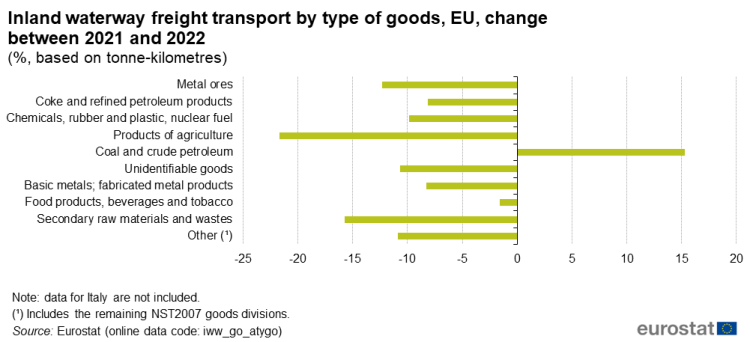
(%, based on tonne-kilometres)
Source: Eurostat - (iww_go_atygo)
Self-propelled barges accounted for more than half of total EU transport performance in 2022
In 2022, the ‘self-propelled barge’ was the predominant type of vessel used for goods transport on EU inland waterways, carrying more than half (51.8 %) of the total EU transport performance, based on tonne-kilometres (Figure 9). The volume of goods transported with self-propelled barges decreased by 7.3 % compared with 2021. The second and third most-used types of vessel were ‘self-propelled tanker barge’ (22.7 %) and ‘barge not self-propelled’ (22.1 %), categories also with decreased use in 2022 compared with 2021 (-6.7 % and -18.4 %, respectively). The transport performance with ‘other goods carrying vessel’ also decreased by 7.1 %. In contrast, ‘seagoing vessel’ registered a large increase (+59.3 %). However, this large change in percentage should be considered in relation to a low initial value, with absolute values increasing from 216 million tonne-kilometres to 345 million tonne-kilometres. Transport performance with ‘Tanker barge not self-propelled’ also increased by 4.4 %.

(billion tonne-kilometres)
Source: Eurostat - (iww_go_atyve)
‘Self-propelled barge’ and ‘barge not self-propelled’ accounted for the largest volumes transported for all countries with the exception of Slovakia and Sweden (Figure 10). Together with ‘self-propelled tanker barges’, they carried out between 94 % and 100 % of the entire transport in 12 out of 15 countries. An exception was Sweden, which reported only ‘seagoing vessels’. The other exceptions were Finland which reported 24 % of ‘seagoing vessels’ and Slovakia, which recorded substantial use of ‘other goods carrying vessels’ (80 %).
In 2022, more than half of the freight transport vessels on EU inland waterways were registered in the Netherlands
In 2022, more than half of the freight transport vessels on EU inland waterways were registered in the Netherlands (50.7 %; Figure 11). The other half was composed of 49 different vessel nationalities of which Germany (15.9 %) and Belgium (9.4 %) had the highest shares.

(%, based on tonne-kilometres)
Source: Eurostat - (iww_g_anave)
When looking at the top three freight transport vessel nationalities in each Member State, in 2021, Dutch and German vessels were in the top three nationalities for six countries out of 15 (Table 1). Dutch vessels were at the first place in Belgium, Germany, Luxembourg and the Netherlands. German vessels were at the first place in Slovakia and second in four countries. Belgium was also well represented in the top three vessel nationalities, with five appearances in second or third position. Romania was also well represented, being first in three countries. In seven countries, the top nationality of vessels performing freight transport was the home nationality: Czechia, France, the Netherlands, Poland, Romania, Finland and Sweden. In Poland and Finland, all vessels were registered in their own country. A similar situation could be seen in Czechia with almost 100 % of Czech vessels. On the contrary, Bulgaria, Croatia, Luxembourg and Hungary did not have vessels registered in their own country in the top three places. All countries had a cumulated share of the top three vessel nationalities higher than 53 %, eight countries had a cumulated share of the top three nationalities higher than 88 % and five countries had a cumulated share of the top three nationalities higher than 91 %.
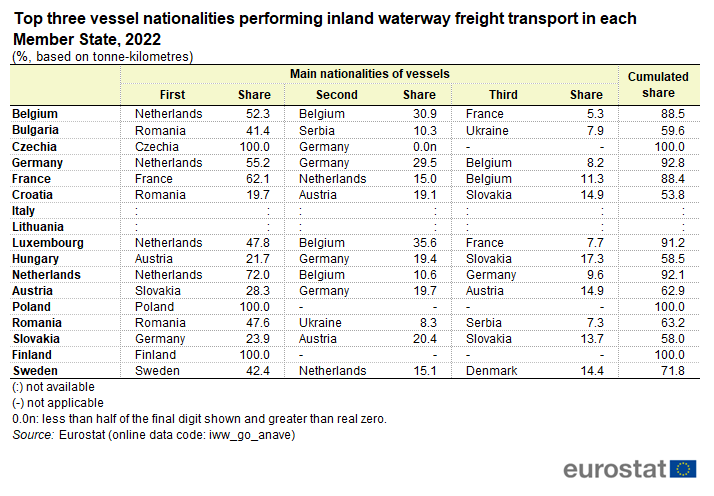
(%, based on tonne-kilometres)
Source: Eurostat - (iww_go_anave)
Container transport performance in 2022 was at the lowest since 2010
The inland waterway transport of freight containers in the EU, measured in twenty-foot equivalent unit-kilometre (TEU-kilometres), showed a consistently upward trend until 2014 (Figure 12). The levels remained relatively stable in 2015 and 2016. An increase was observed in 2017, reaching a new peak in container transport. In 2018, 2019 and 2020, three sharp declines were recorded (-8.6 %, -3.1 % and -4.9 % compared with the previous year, respectively). In 2021, a rebound was observed with a 4.2 % increase compared to 2020. In 2022, a substantial downturn was observed, by 8.1 %, leading to the lowest point (1.4 billion TEU-kilometres) in container transport performance since 2010 (1.3 billion TEU-kilometres).
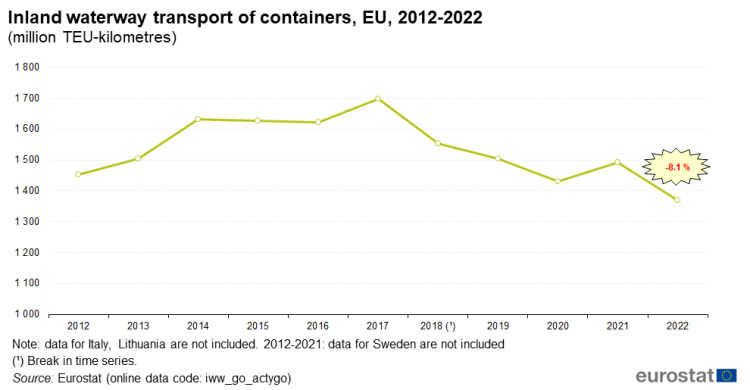
(million TEU-kilometres)
Source: Eurostat - (iww_go_actygo)
At quarterly level, a global increase in trend is visible from 2014 to mid-2018 (Figure 13). Strong increases were recorded in 2017 leading to a new peak in the third quarter of 2017 (453 million TEU-kilometres). In 2018, considerable decreases were observed in the third and fourth quarters of 2018 compared with the same quarters of 2017 (-12.2 % and -30.4 %, respectively). This led to a new low point in the fourth quarter of 2018 (304 million TEU-kilometres). The year 2019 also started with sharp declines but ended with a strong increase in the fourth quarter (+18.7 %). In 2021, increases were observed in the two first quarters compared with the same quarters of 2020 (+3.5 % and +19.6 %, respectively), whereas, there were declines in the third and fourth quarters 2021 (-3.8 % and -0.2 %, respectively). In 2022, there were substantial decreases in all quarters, even if more moderate in the second quarter (-3.0 %): -6.7 % in the first quarter, -12.5 % in the third quarter and -10.8 % in the fourth quarter.
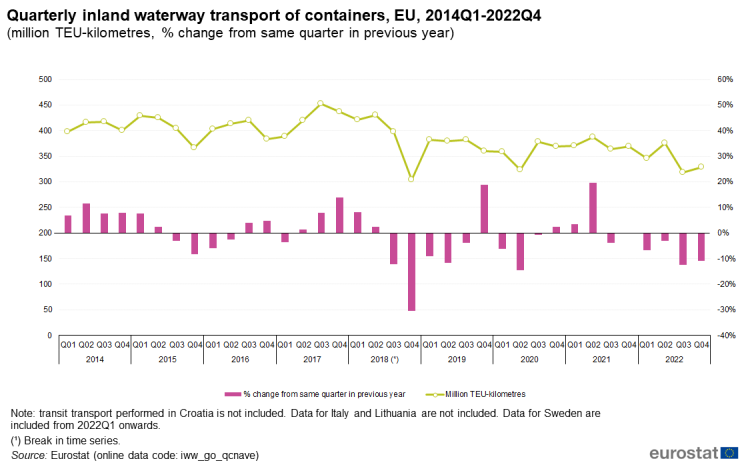
(million TEU-kilometres, % change from same quarter in previous year)
Source: Eurostat - (iww_go_qcnave)
In 2022, the largest contribution to transport of containers (in TEU-kilometres) came from the Netherlands, followed by Germany (Figure 14). Together, the two countries accounted for 86 % of all the EU container transport. All countries reporting containers transport recorded a drop in container transport in 2022 compared with 2021, with the exception of Romania (+862.1 %), Bulgaria (+3 048.8 %) and Croatia (+153.2 %). However, these large changes in percentage should be considered in relation to the low initial values. Three countries reported no transport of containers in 2012, 2021 and 2022: Czechia, Poland and Finland. In addition, Slovakia reported no transport of containers in 2012 and 2022, while 6 724 TEU-kilometres were reported in 2021. Besides Slovakia, the highest decrease in container transport performance in 2022 was recorded by Austria (-80.3 %), followed by Luxembourg (-26.1 %), Hungary (-23.2 %), Belgium (-11.7 %), Germany (-10.9 %), France (-7.5 %) and the Netherlands (-6.8 %).
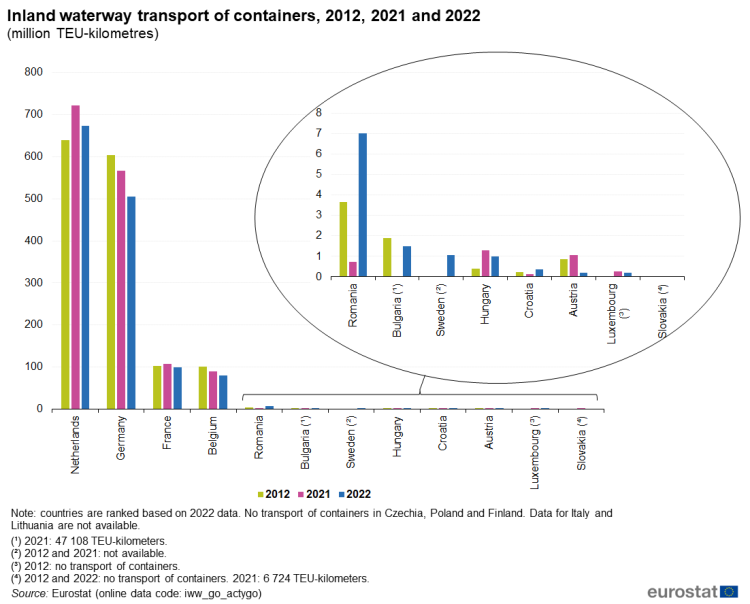
(million TEU-kilometres)
Source: Eurostat - (iww_go_actygo)
When looking at the loading status of containers, EU transport of loaded containers in 2022 accounted for more than two thirds of total EU container transport (70.5 %). Sweden was the country with the highest share of transport of loaded containers with 89.9 %, followed by Belgium (72.1 %), Germany (71.5 %), the Netherlands (70.9 %) and France (64.2 %). Austria recorded transport of empty containers only in 2022. The remaining countries transported more empty containers than loaded containers: Hungary (99.0 % of empty containers, Croatia (98.3 %), Bulgaria (86.0 %), Luxembourg (82.2 %) and Romania (54.1 %).

(%, based on TEU-kilometres)
Source: Eurostat - (iww_go_actygo)
‘Flammable liquids’ is the most transported dangerous goods category in EU inland waterways
The transport of dangerous goods is a voluntary data collection. Nine out of 17 countries reported data on transport of dangerous goods in 2022 (Table 2). While it is still difficult to identify the types of dangerous goods transported at EU level due to lack of data for all EU Member States, it can be observed that ‘flammable liquids’ was the main category in all the countries reporting such data. Overall, 'flammable liquids' accounted for 53 % of the total tonnage of transported dangerous goods. Czechia reported no transport of dangerous goods in 2022.
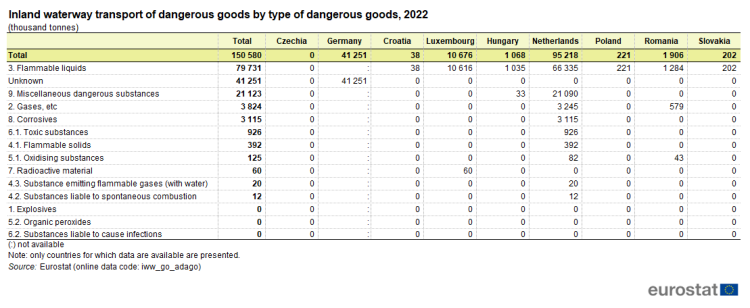
(thousand tonnes)
Source: Eurostat - (iww_go_adago)
Source data for tables and graphs
Data sources
All figures presented in this article have been extracted from the Eurostat online inland waterways transport database. The related datasets are collected according to Regulation (EU) No 2018/974 of the European Parliament and of the Council on statistics of goods transport by inland waterways. Regulation (EU) No 2018/974 consolidated the initial Regulation (EC) No 1365/2006 on statistics of goods transport by inland waterways and all its implementing and amending legal acts: Commission Regulation (EC) No 425/2007 (implementing regulation), Commission Regulation (EC) No 1304/2007 (amending regulation) and Regulation (EU) No 2016/1954 (amending regulation).
Regulation (EU) 2018/974 states that data must be supplied by all Member States for which the total volume of goods transported annually by inland waterways exceeds 1 million tonnes. Currently, 17 Member States provide data on mandatory or voluntary basis: Belgium (BE), Bulgaria (BG), Czechia (CZ), Germany (DE), France (FR), Croatia (HR), Italy (IT), Lithuania (LT), Luxembourg (LU), Hungary (HU), the Netherlands (NL), Austria (AT), Poland (PL), Romania (RO), Slovakia (SK), Finland (FI) and Sweden (SE). The legal act requires only the provision of a reduced annual dataset for countries exceeding the 1-million-tonne threshold but where no international or transit traffic exists.
Definitions
National inland waterway transport: Inland waterway transport between two ports of a national territory irrespective of the nationality of vessel.
International inland waterway transport: Inland waterway transport between two ports located in different national territories.
Transit inland waterway transport: Inland waterway transport through a national territory between two ports both located in another national territory or national territories provided that in the total journey within the national territory there is no transshipment.
Calculation of EU aggregates: In Figures 5 and 6, the EU international and total goods transport in tonnes is calculated excluding double counting. In order to achieve that, the EU total international transport is calculated by adding the international unloadings declared by the EU countries plus the international loading for which the unloading country is not in the EU. Then, the EU total transport is calculated by adding the national transport and the total international transport.
For transit transport measured in tonnes, an EU aggregate equal to the sum of the country figures is not valid because volumes of freight transported are reported by all transit countries through which the transport takes place before reaching the unloading destination. Therefore, the same volume may be reported two, three, or more times without the possibility to eliminate multiple counting. At the same time, figures for transit transport are included in the EU national or international transport as they are reported not only by the transit countries but also by the loading and unloading countries. So, for the EU total volume of freight, it is enough to sum the total national and international figures.
Country specific notes
Belgium: A break in time series can be observed in 2018 due to an improvement of the data collection system.
Bulgaria: Transit data supplied include Romanian national IWW transport data equivalent to Bulgarian transit transport.
Croatia: Quarterly transit transport is not available.
Italy: No data available for 2022. Data are delivered on a voluntary basis. Only a simplified annual dataset is provided.
Lithuania: Data are delivered on a voluntary basis. Only a simplified annual dataset is provided.
Hungary: Due to a methodological change, transit data are underestimated for the third quarter 2013 and are not comparable with the other quarters.
Romania: Transit data supplied include Bulgarian national IWW transport data equivalent to Romanian transit transport.
Finland: No data available for 2017 and 2018. Data are delivered on a voluntary basis. Only a simplified annual dataset is provided until 2016.
Sweden: Data were delivered on a voluntary basis until 2021. Only a simplified annual dataset was provided until 2021.
Breakdown by group of goods The NST 2007 classification is available on RAMON.
Symbols
- ":" not available
- "-" not applicable
- "0" real zero
Context
The content of this statistical article is based on data collected within the framework of Regulation (EU) No 2018/974 of the European Parliament and of the Council on statistics of goods transport by inland waterways.
Direct access to
- Transport, see table under 'Inland waterways transport':
- Inland waterways transport (t_iww)
- Goods transport by inland waterways (ttr00007)
- Transport, see datasets under the following categories:
- Inland waterways transport (iww)
- Inland waterways transport infrastructure (iww_if)
- Inland waterways transport equipment (iww_eq)
- Inland waterways transport - Enterprises, economic performances and employment (iww_ec)
- Inland waterways transport measurement - goods (iww_go)
- Inland waterways - accidents (iww_ac)
- Regulation (EU) No 2018/974 of the European Parliament and of the Council on statistics of goods transport by inland waterways
- Summaries of EU legislation: EU statistics of goods transport by inland waterways
- Regulation (EC) No 1365/2006 on statistics of goods transport by inland waterways
- Commission Regulation (EC) No 425/2007 (implementing regulation)
- Commission Regulation (EC) No 1304/2007 (amending regulation)
- Regulation (EU) No 2016/1954 (amending regulation)
